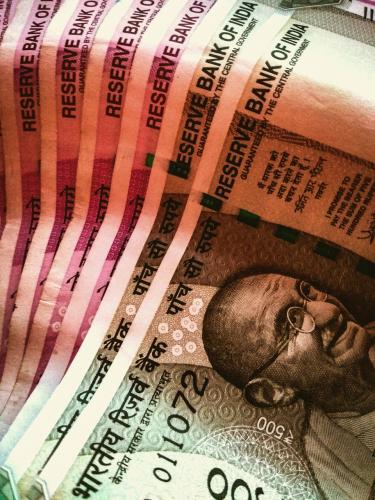
The MPC of the RBI caught almost everyone by surprise by keeping the policy repo rate unchanged at 6.5 per cent in its fourth bi-monthly meeting for 2018-19 by a 5-1 majority. However, it changed its stance from ‘neutral’ to what it called ‘calibrated tightening’.
An overwhelming majority of market participants and observers had expected the policy rate to be hiked by at least 25 basis points (bps) to address the likely higher core inflation arising out of the soaring crude oil price, falling rupee, on the one hand, and to maintain the interest rate differential vis-à-vis the US for resisting capital outflows, on the other.
As regards inflation, there was a positive surprise in the sense that, in the words of MPC, ‘actual inflation outcomes, especially in August, were below projections as the expected seasonal increase in food prices did not materialise and inflation excluding food and fuel moderated.’
In the immediate aftermath of the policy announcement, while the rupee and the equity market dropped significantly, the yield on the benchmark 10-year government security firmed up by about 10 bps. Incidentally, in a rare coincidence, the financial markets in India and elsewhere are braced for another important announcement today, when in the early hours of trading in New York, the non-farm payroll data for September 2018 will be released which are expected to provide important clues as regards the future direction of the policy rate of the Federal Reserve.
Policy rationale
In the assessment of the MPC, the economy’s growth performance and demand conditions are fairly robust. The growth projections for the second half of 2018-19 and first quarter of 2019-20 are more or less unchanged vis-à-vis those made at the time of the third policy in August, with risks broadly balanced. As regards inflation, there was a positive surprise in the sense that, in the words of MPC, ‘actual inflation outcomes, especially in August, were below projections as the expected seasonal increase in food prices did not materialise and inflation excluding food and fuel moderated.’
The projections for CPI inflation are now 3.9-4.5 per cent in H2 2018-19 and 4.8 per cent in Q1 2019-20, even after factoring in the rise in the price of crude oil and the rupee fall, as against 4.8 per cent in H2 2018-19 and 5 per cent in Q1 2019-20 in the third bi-monthly meeting.
It seems that the improvement in the inflation outlook, especially in respect of food items like pulses, edible oils, sugar, fruits and vegetables, and reasonably good prospects for both kharif and rabi crops have influenced MPC’s decision.
We will have to wait for the publication of the minutes of this meeting later this month to know if the MPC felt that the two back-to-back policy rate hikes effected in the previous two meetings are showing results in keeping the core inflation under control.
The setting for this bi-monthly meeting was not ordinary. The financial markets in India are now experiencing extreme volatility and uncertainty, because of global and local factors. The latter included the debt default by a triple-A rated shadow-banking behemoth and its spillover to other segments bringing down equity and bond prices. As a consequence, the yield on a one-year treasury bill rose to 7.75 per cent on the eve of the meeting, signifying a high real yield of about 3 per cent.
Dealing with the present rupee volatility will possibly need a relook at the framework and tools used for market intervention by the RBI. At the present juncture, the effectiveness of intervention is reduced by the RBI’s compulsion to provide ample liquidity in the face of the developments in the credit market triggered by the debt default.
A further rise in the policy rate could have pushed real yield even higher, which could have harmed the economy. The MPC seems to have taken a correct judgment call that despite the 10-year government security yield rising by about 40 bps since the August meeting, the monetary policy is not ‘behind the curve’, as inflation has behaved well.
Remit of MPC
But the question that is in everyone’s mind post the policy is: Shouldn’t the MPC policy calculus take into consideration the need to stabilise the rupee’s exchange rate movement? The policy statement at one place observes that ‘global financial markets continued to be affected by monetary policy stances in major advanced economies (AEs)’.
Given that the monetary policy stances of AEs are shaped by their respective domestic considerations, will it be reasonable to expect explicit monetary policy responses, among other measures, to arrest the rupee’s recent sharp fall? Perhaps not, since inclusion of any other objective to the ‘inflation target and growth’ remit of the MPC will dilute its focus and effectiveness.
Dealing with the present rupee volatility will possibly need a relook at the framework and tools used for market intervention by the RBI. At the present juncture, the effectiveness of intervention is reduced by the RBI’s compulsion to provide ample liquidity in the face of the developments in the credit market triggered by the debt default mentioned earlier.
On other measures, the decision to formulate regulations for financial benchmarks is timely. However, the actual use of benchmarks for the pricing of financial products will depend on their liquidity, for establishing which appropriate derivative products, preferably futures contracts, need to be designed and introduced in the Indian exchanges.
(The writer is a former central banker and consultant to the IMF)



